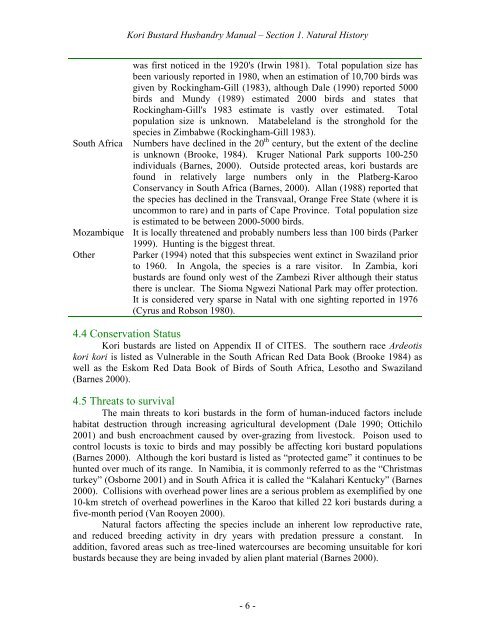Kori Bustard Husbandry Manual - Gruiformes
Kori Bustard Husbandry Manual - Gruiformes
Kori Bustard Husbandry Manual - Gruiformes
You also want an ePaper? Increase the reach of your titles
YUMPU automatically turns print PDFs into web optimized ePapers that Google loves.
<strong>Kori</strong> <strong>Bustard</strong> <strong>Husbandry</strong> <strong>Manual</strong> – Section 1. Natural History<br />
was first noticed in the 1920's (Irwin 1981). Total population size has<br />
been variously reported in 1980, when an estimation of 10,700 birds was<br />
given by Rockingham-Gill (1983), although Dale (1990) reported 5000<br />
birds and Mundy (1989) estimated 2000 birds and states that<br />
Rockingham-Gill's 1983 estimate is vastly over estimated. Total<br />
population size is unknown. Matabeleland is the stronghold for the<br />
species in Zimbabwe (Rockingham-Gill 1983).<br />
South Africa Numbers have declined in the 20 th century, but the extent of the decline<br />
is unknown (Brooke, 1984). Kruger National Park supports 100-250<br />
individuals (Barnes, 2000). Outside protected areas, kori bustards are<br />
found in relatively large numbers only in the Platberg-Karoo<br />
Conservancy in South Africa (Barnes, 2000). Allan (1988) reported that<br />
the species has declined in the Transvaal, Orange Free State (where it is<br />
uncommon to rare) and in parts of Cape Province. Total population size<br />
is estimated to be between 2000-5000 birds.<br />
Mozambique It is locally threatened and probably numbers less than 100 birds (Parker<br />
1999). Hunting is the biggest threat.<br />
Other Parker (1994) noted that this subspecies went extinct in Swaziland prior<br />
to 1960. In Angola, the species is a rare visitor. In Zambia, kori<br />
bustards are found only west of the Zambezi River although their status<br />
there is unclear. The Sioma Ngwezi National Park may offer protection.<br />
It is considered very sparse in Natal with one sighting reported in 1976<br />
(Cyrus and Robson 1980).<br />
4.4 Conservation Status<br />
<strong>Kori</strong> bustards are listed on Appendix II of CITES. The southern race Ardeotis<br />
kori kori is listed as Vulnerable in the South African Red Data Book (Brooke 1984) as<br />
well as the Eskom Red Data Book of Birds of South Africa, Lesotho and Swaziland<br />
(Barnes 2000).<br />
4.5 Threats to survival<br />
The main threats to kori bustards in the form of human-induced factors include<br />
habitat destruction through increasing agricultural development (Dale 1990; Ottichilo<br />
2001) and bush encroachment caused by over-grazing from livestock. Poison used to<br />
control locusts is toxic to birds and may possibly be affecting kori bustard populations<br />
(Barnes 2000). Although the kori bustard is listed as “protected game” it continues to be<br />
hunted over much of its range. In Namibia, it is commonly referred to as the “Christmas<br />
turkey” (Osborne 2001) and in South Africa it is called the “Kalahari Kentucky” (Barnes<br />
2000). Collisions with overhead power lines are a serious problem as exemplified by one<br />
10-km stretch of overhead powerlines in the Karoo that killed 22 kori bustards during a<br />
five-month period (Van Rooyen 2000).<br />
Natural factors affecting the species include an inherent low reproductive rate,<br />
and reduced breeding activity in dry years with predation pressure a constant. In<br />
addition, favored areas such as tree-lined watercourses are becoming unsuitable for kori<br />
bustards because they are being invaded by alien plant material (Barnes 2000).<br />
- 6 -


